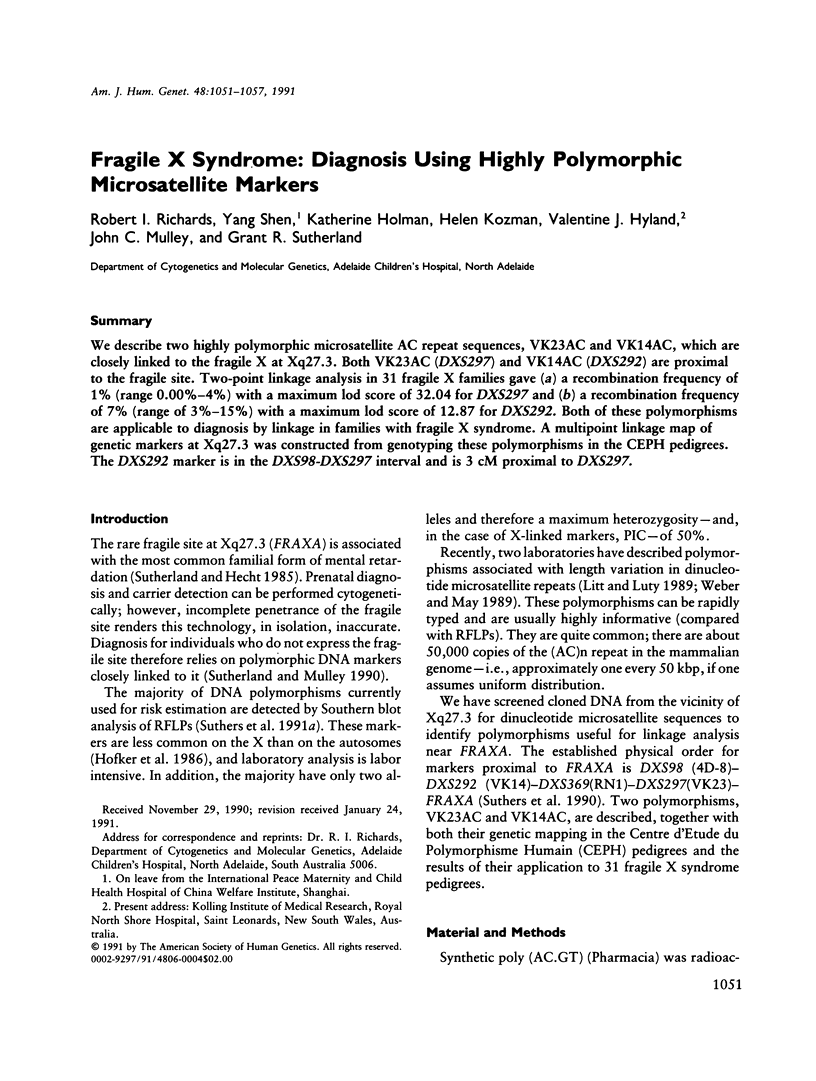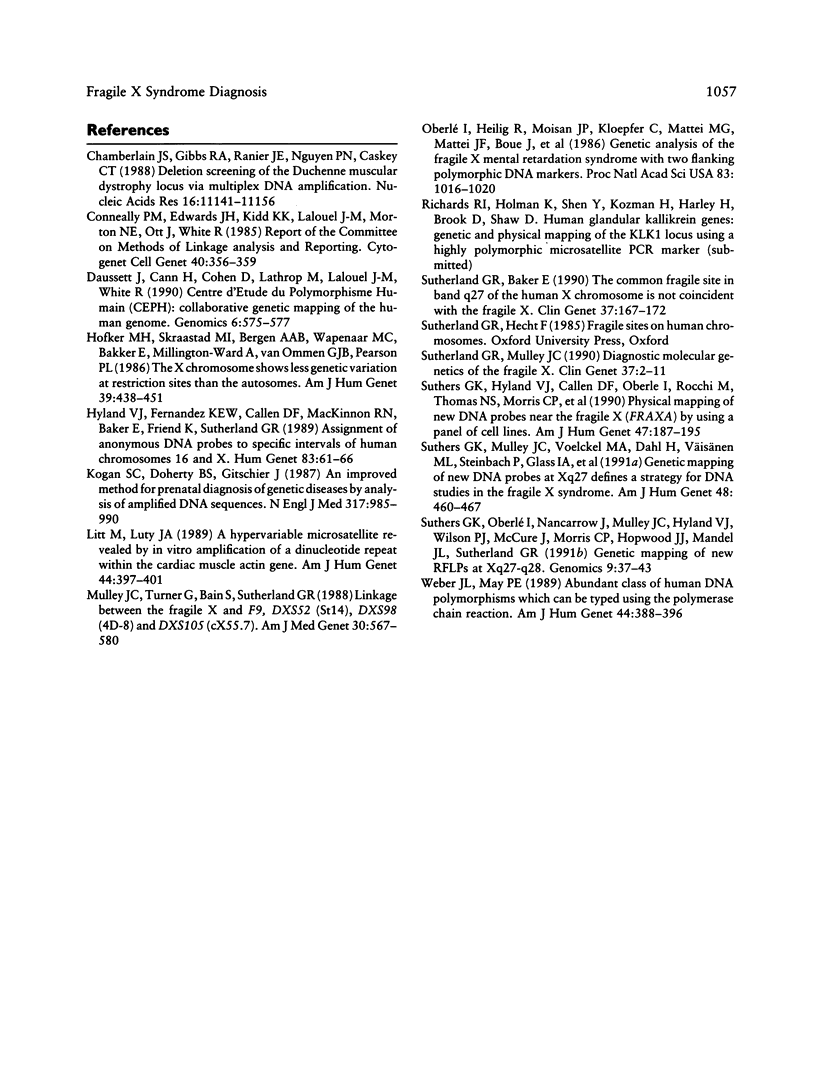Abstract
We describe two highly polymorphic microsatellite AC repeat sequences, VK23AC and VK14AC, which are closely linked to the fragile X at Xq27.3. Both VK23AC (DXS297) and VK14AC (DXS292) are proximal to the fragile site. Two-point linkage analysis in 31 fragile X families gave (a) a recombination frequency of 1% (range 0.00%-4%) with a maximum lod score of 32.04 for DXS297 and (b) a recombination frequency of 7% (range of 3%-15%) with a maximum lod score of 12.87 for DXS292. Both of these polymorphisms are applicable to diagnosis by linkage in families with fragile X syndrome. A multipoint linkage map of genetic markers at Xq27.3 was constructed from genotyping these polymorphisms in the CEPH pedigrees. The DXS292 marker is in the DXS98-DXS297 interval and in 3 cM proximal to DXS297.
Full text
PDF






Images in this article
Selected References
These references are in PubMed. This may not be the complete list of references from this article.
- Chamberlain J. S., Gibbs R. A., Ranier J. E., Nguyen P. N., Caskey C. T. Deletion screening of the Duchenne muscular dystrophy locus via multiplex DNA amplification. Nucleic Acids Res. 1988 Dec 9;16(23):11141–11156. doi: 10.1093/nar/16.23.11141. [DOI] [PMC free article] [PubMed] [Google Scholar]
- Conneally P. M., Edwards J. H., Kidd K. K., Lalouel J. M., Morton N. E., Ott J., White R. Report of the Committee on Methods of Linkage Analysis and Reporting. Cytogenet Cell Genet. 1985;40(1-4):356–359. doi: 10.1159/000132186. [DOI] [PubMed] [Google Scholar]
- Dausset J., Cann H., Cohen D., Lathrop M., Lalouel J. M., White R. Centre d'etude du polymorphisme humain (CEPH): collaborative genetic mapping of the human genome. Genomics. 1990 Mar;6(3):575–577. doi: 10.1016/0888-7543(90)90491-c. [DOI] [PubMed] [Google Scholar]
- Hofker M. H., Skraastad M. I., Bergen A. A., Wapenaar M. C., Bakker E., Millington-Ward A., van Ommen G. J., Pearson P. L. The X chromosome shows less genetic variation at restriction sites than the autosomes. Am J Hum Genet. 1986 Oct;39(4):438–451. [PMC free article] [PubMed] [Google Scholar]
- Hyland V. J., Fernandez K. E., Callen D. F., MacKinnon R. N., Baker E., Friend K., Sutherland G. R. Assignment of anonymous DNA probes to specific intervals of human chromosomes 16 and X. Hum Genet. 1989 Aug;83(1):61–66. doi: 10.1007/BF00274150. [DOI] [PubMed] [Google Scholar]
- Kogan S. C., Doherty M., Gitschier J. An improved method for prenatal diagnosis of genetic diseases by analysis of amplified DNA sequences. Application to hemophilia A. N Engl J Med. 1987 Oct 15;317(16):985–990. doi: 10.1056/NEJM198710153171603. [DOI] [PubMed] [Google Scholar]
- Litt M., Luty J. A. A hypervariable microsatellite revealed by in vitro amplification of a dinucleotide repeat within the cardiac muscle actin gene. Am J Hum Genet. 1989 Mar;44(3):397–401. [PMC free article] [PubMed] [Google Scholar]
- Mulley J., Turner G., Bain S., Sutherland G. R. Linkage between the fragile X and F9, DXS52 (St14), DXS98 (4D-8) and DXS105 (cX55.7). Am J Med Genet. 1988 May-Jun;30(1-2):567–580. doi: 10.1002/ajmg.1320300158. [DOI] [PubMed] [Google Scholar]
- Oberlé I., Heilig R., Moisan J. P., Kloepfer C., Mattéi G. M., Mattéi J. F., Boué J., Froster-Iskenius U., Jacobs P. A., Lathrop G. M. Genetic analysis of the fragile-X mental retardation syndrome with two flanking polymorphic DNA markers. Proc Natl Acad Sci U S A. 1986 Feb;83(4):1016–1020. doi: 10.1073/pnas.83.4.1016. [DOI] [PMC free article] [PubMed] [Google Scholar]
- Sutherland G. R., Baker E. The common fragile site in band q27 of the human X chromosome is not coincident with the fragile X. Clin Genet. 1990 Mar;37(3):167–172. doi: 10.1111/j.1399-0004.1990.tb03498.x. [DOI] [PubMed] [Google Scholar]
- Sutherland G. R., Mulley J. C. Diagnostic molecular genetics of the fragile X. Clin Genet. 1990 Jan;37(1):2–11. doi: 10.1111/j.1399-0004.1990.tb03383.x. [DOI] [PubMed] [Google Scholar]
- Suthers G. K., Hyland V. J., Callen D. F., Oberle I., Rocchi M., Thomas N. S., Morris C. P., Schwartz C. E., Schmidt M., Ropers H. H. Physical mapping of new DNA probes near the fragile X mutation (FRAXA) by using a panel of cell lines. Am J Hum Genet. 1990 Aug;47(2):187–195. [PMC free article] [PubMed] [Google Scholar]
- Suthers G. K., Mulley J. C., Voelckel M. A., Dahl N., Väisänen M. L., Steinbach P., Glass I. A., Schwartz C. E., van Oost B. A., Thibodeau S. N. Genetic mapping of new DNA probes at Xq27 defines a strategy for DNA studies in the fragile X syndrome. Am J Hum Genet. 1991 Mar;48(3):460–467. [PMC free article] [PubMed] [Google Scholar]
- Suthers G. K., Oberlé I., Nancarrow J., Mulley J. C., Hyland V. J., Wilson P. J., McCure J., Morris C. P., Hopwood J. J., Mandel J. L. Genetic mapping of new RFLPs at Xq27-q28. Genomics. 1991 Jan;9(1):37–43. doi: 10.1016/0888-7543(91)90218-4. [DOI] [PubMed] [Google Scholar]
- Weber J. L., May P. E. Abundant class of human DNA polymorphisms which can be typed using the polymerase chain reaction. Am J Hum Genet. 1989 Mar;44(3):388–396. [PMC free article] [PubMed] [Google Scholar]



